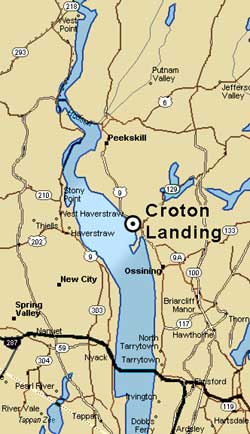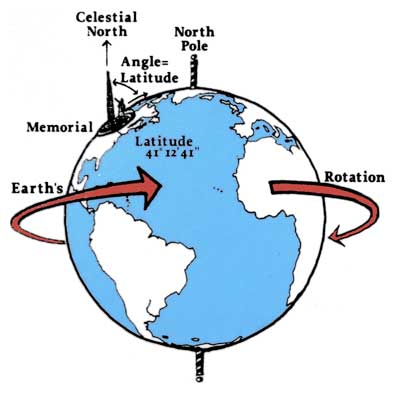The Hudson River flows 315 miles from Lake Tear of the Clouds on Mount Marcy to the Verrazano Narrows between Staten Island and Brooklyn, falling 4600 feet along the way. Essentially all of that drop is in the upper half. From Troy to the Atlantic Ocean, the river only descends two feet. Parts of it are actually below mean sea level.
 Haverstraw Bay, highlighted on the map, is one of those places. Here the
Hudson is less a river and more of a
tidal estuary. Except for the man-made ship channel,
the bay is barely ten feet deep. The water is
brackish, as the fresh water from the Adirondacks merges gradually
with the Atlantic Ocean.
Haverstraw Bay, highlighted on the map, is one of those places. Here the
Hudson is less a river and more of a
tidal estuary. Except for the man-made ship channel,
the bay is barely ten feet deep. The water is
brackish, as the fresh water from the Adirondacks merges gradually
with the Atlantic Ocean.
 The bay is a playground for these daysailers. This place is home to over 200
species of fish, including sturgeon and shad. Oysters, clams, and crabs
abound here. It wasn't always that way.
The bay is a playground for these daysailers. This place is home to over 200
species of fish, including sturgeon and shad. Oysters, clams, and crabs
abound here. It wasn't always that way.
In 1887, over 2½ million pounds of shad were caught here, but pollution reduced the catch to less than 80 thousand pounds by 1966. That year, Pete Seeger announced plans to "build a boat to save the river." In 1969, he launched the Clearwater, which has been called America's Environmental Flagship. The advocacy that grew around the ship and the Clearwater Festival got things moving to clean up the river, and the shad harvest is now over 200 thousand pounds annually. The Clearwater project and the Hudson River stand as examples of how effective local activism can be to promote conservation and environmental responsibility.
 Croton Landing Park celebrates the rehabilitated Hudson River on the east
shore of Haverstraw Bay.
Its half-mile paved walkway is part of the
51-mile
Westchester RiverWalk (33 miles are complete). The park itself is a good example
of reclaiming the beauty that was almost lost. It's sandwiched between the
river and the railroad on the site of an old asphalt factory, where over 100
years' accumulated junk had to be removed from the river. Breakwaters make
lagoons that attract many local and migratory birds: ducks, geese, egrets,
herons, ….
Croton Landing Park celebrates the rehabilitated Hudson River on the east
shore of Haverstraw Bay.
Its half-mile paved walkway is part of the
51-mile
Westchester RiverWalk (33 miles are complete). The park itself is a good example
of reclaiming the beauty that was almost lost. It's sandwiched between the
river and the railroad on the site of an old asphalt factory, where over 100
years' accumulated junk had to be removed from the river. Breakwaters make
lagoons that attract many local and migratory birds: ducks, geese, egrets,
herons, ….
 One section of the path splits to a short boardwalk, where you can get a
close look at the wetland while keeping your feet dry.
If you look over to Haverstraw Bay's west shore from that place, you can see
the hill called Sleeping Indian. If you
see an Indian there, your imagination is better than mine. His head is
downstream (left), toes pointing the way to Albany.
One section of the path splits to a short boardwalk, where you can get a
close look at the wetland while keeping your feet dry.
If you look over to Haverstraw Bay's west shore from that place, you can see
the hill called Sleeping Indian. If you
see an Indian there, your imagination is better than mine. His head is
downstream (left), toes pointing the way to Albany.
In September 2001, nineteen self-styled Moslem warriors attacked the United States, against which their leader had declared war five years earlier (original document). Part of the damage was the collapse of the twin towers of New York's World Trade Center, where a number of Croton residents were among almost three thousand who died within a few hours that morning. This exceeded the 1941 Pearl Harbor death toll by several hundred, an assault that provoked the U.S. Congress to its last-ever declaration of war the following morning.
Croton architect James W. Rhodes witnessed the destruction, which
understandably affected him deeply. He designed a
monument to those whose lives were snuffed or transformed that day, securing
a 14-foot steel beam from the North Tower as a
centerpiece.
 Recovered steel from the twin towers has been used as a memorial in each of
the fifty states – we saw a
moving example in the International Peace
Garden a few years ago. But rather than simply display the wreckage, Mr.
Rhodes decided to use Croton's I-beam as the gnomon of a large sundial,
32 feet in diameter.
It's
Dial #769
on the registry of the North American Sundial Society.
Recovered steel from the twin towers has been used as a memorial in each of
the fifty states – we saw a
moving example in the International Peace
Garden a few years ago. But rather than simply display the wreckage, Mr.
Rhodes decided to use Croton's I-beam as the gnomon of a large sundial,
32 feet in diameter.
It's
Dial #769
on the registry of the North American Sundial Society.
This is a work in progress. First the sundial was built, then local artist Lauren Davis's bronze sculpture was incorporated. There will eventually be a small memorial garden at the site.

 Miss Davis's life-size figure captures the theme of the memorial,
Reaching Through the Shadow. It's a woman who stretches toward the
beam but doesn't quite touch it, expressing faith and strength.
Miss Davis's life-size figure captures the theme of the memorial,
Reaching Through the Shadow. It's a woman who stretches toward the
beam but doesn't quite touch it, expressing faith and strength.
A sign at the site shows the most elegant explanation I've ever seen, how a sundial works. The gnomon has a line parallel to the Earth's north-south axis, which casts a time-telling shadow as our planet rotates. Its angle from the ground is the same as the site's latitude. So if you buy a sundial in Florida, it won't be accurate in New York. Many popular designs are adjustable for this reason. Check that angle if yours isn't one of them.

 Obviously, the gnomon must point to True North. Mr. Rhodes had a challenge
here, because his gnomon has a compound twist. He had to take the shape into
account when he designed the mount on a 16-ton gneiss boulder that was found
nearby. Both the orientation and elevation of the base are calculated so
that the top of the beam is accurate at its free end. As you can
see from the architect's plan, the top of
the beam tells the time.
Obviously, the gnomon must point to True North. Mr. Rhodes had a challenge
here, because his gnomon has a compound twist. He had to take the shape into
account when he designed the mount on a 16-ton gneiss boulder that was found
nearby. Both the orientation and elevation of the base are calculated so
that the top of the beam is accurate at its free end. As you can
see from the architect's plan, the top of
the beam tells the time.

The sign at the edge of the walkway instructs us to read the time from where the shadow "falls farthest from the Sun." That would be the left edge in the morning, right edge after noon (1 PM daylight time). This is not always the longest part of the shadow, so some care is in order. Be sure that your reference is the part of the shadow from the top of the beam. For the truly fastidious, there is a graph on the same sign that shows the Equation of Time, to account for small discrepancies between solar time and clock time throughout the year.
 Architecture is the marriage of art and engineering. Mr. Rhodes made nine
medallions to mark the passage of time, commemorating events and the people
who responded to them on that awful day. For elegance of design, the sundial
only registers from 8 AM to 4 PM, so you'll need to do some
extrapolation on summer mornings and evenings. Or use your watch.
Architecture is the marriage of art and engineering. Mr. Rhodes made nine
medallions to mark the passage of time, commemorating events and the people
who responded to them on that awful day. For elegance of design, the sundial
only registers from 8 AM to 4 PM, so you'll need to do some
extrapolation on summer mornings and evenings. Or use your watch.
 The memorial is at the end of Croton Landing, where the Westchester RiverWalk
is interrupted for the time being. This requires
one to walk a
bit to see it, like some kind of pilgrimage. But the site, and the time it
takes to walk there,
offer an opportunity for reflection; and the location affords a clear
view down the Hudson, past Croton Point and Hook Mountain.
The memorial is at the end of Croton Landing, where the Westchester RiverWalk
is interrupted for the time being. This requires
one to walk a
bit to see it, like some kind of pilgrimage. But the site, and the time it
takes to walk there,
offer an opportunity for reflection; and the location affords a clear
view down the Hudson, past Croton Point and Hook Mountain.
 The base of the monument is surrounded by dense wild rose, which is ubiquitous
at Croton Landing. The thorns and blood-red fruit symbolize the
tragedy of the 11th of September 2001.
The base of the monument is surrounded by dense wild rose, which is ubiquitous
at Croton Landing. The thorns and blood-red fruit symbolize the
tragedy of the 11th of September 2001.
 About 4:00 every afternoon (Standard Time), the shadow falls on
Lauren Davis's sculpture, who reaches through it in a gesture of hope and
remembrance. Visitors sometimes add a small American flag to her left
hand.
About 4:00 every afternoon (Standard Time), the shadow falls on
Lauren Davis's sculpture, who reaches through it in a gesture of hope and
remembrance. Visitors sometimes add a small American flag to her left
hand.
A bronze plaque honors the local people who died because of the attack on New York.
Buchanan • Cortlandt • Croton-on-Hudson
9/11 Remembrance Memorial at Croton Landing
Reaching Through the Shadow
Dedicated to all who lost their lives on
| William F. Abrahamson
Town of Cortlandt |
Gregory E. Rodriguez
Village of Croton-on-Hudson |
| FF George C. Cain
1st Responder, FDNY |
Thomas E. Sinton III
Town of Cortlandt |
| PO Stephen P. Driscoll
1st Responder, NYPD |
Randall L. Sprance
2nd Responder, Dept. of Treas. |
| James A Oakley
Town of Cortlandt |
Joseph J. Zuccala
Town of Cortlandt |